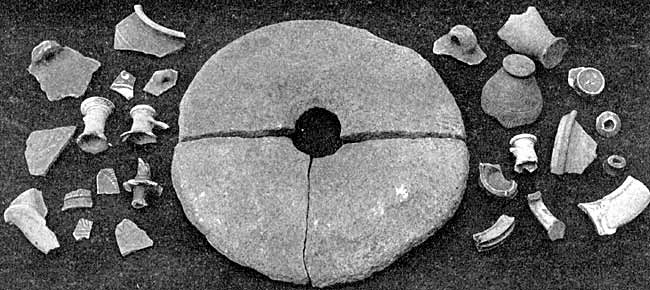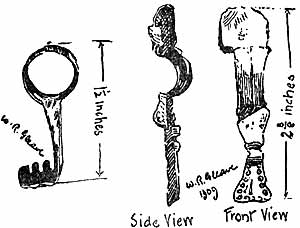 Roman remains found at Margidunum, near Bingham.
Roman remains found at Margidunum, near Bingham.Mr. G. H. Wallis, curator of the Castle Museum, Nottingham, has kindly lent and placed at my disposal, the above plan and account of these researches, made and written in 1884, by the late Mr. Frank Miles, of Bingham. It is reproduced verbatim. Some of the “finds” were sent to and are still lodged at the Castle Museum, and Mr. Wallis has generously offered to have a group or two photographed, with a view to illustration.
Mr. Frank Miles endorses his manuscript with the following remarks:—“I hope this will be some use for the comparative archaeologist to go upon. What we want is someone to make a map of Roman Nottinghamshire indicating such stations as Stathern or Hickling, West Bridgeford or Burghford, Southwell, Castle Hill, Willoughby, Segs Hill, and showing their relations to each other and the Fosse.”
He also adds a marginal note to his manuscript, which reads as follows:—“Someone ought to clear up the difficulty about the distances given in Antonine.”
This note touches a practically unsolved difficulty about the site of Ad Pontem. In the past, claims have been put in by different antiquaries for Southwell, Farndon, Stoke, and Newark. The difficulty arises from the fact that Ad Pontem appears as a station in one of the Itineraries of Antoninus Augustus, and while inserted in the iter going north it is omitted in the iter going south. They run thus :
| Lindo (Lincoln) | |
| Crococalana (Brough) | xiiii. |
| Margiduno (East Bridgford) | xiiii. |
| Verometo (Willoughby) | xii |
| Verometo (Willoughby) | xiii |
| Margiduno (East Bridgford) | vii (or) xiiii. |
| Ad Pontem | vii (or) xiiii. |
| Crocolana (Brough) | vii. |

Roman remains found at Margidunum, near Bingham.
There are strong reasons for doubting the correctness of the iter going north. Two successive marches of seven miles each would be unique in the Roman itineraries, and are on this account highly improbable. Again the manuscripts differ as to the mileage, fourteen miles as well as seven miles being given as the distance between Crococalanum and the next station to the south.
On these grounds the late Rev. R. F. Smith, of Southwell, held Ad. Pontem to have been originally a marginal note attached to Margidunum and indicating the road westwards to the bridge of boats across the Trent; and that at a later date some ignorant scribe inserted this note into the, text and, dividing the fourteen miles into two equal distances, made Ad Pontem a station.1
There are two objections at least to the Rev. R. P. Smith’s theory. First, Ad Pontem may well mean ‘in the neighbourhood of the bridge.’ This force of the preposition is shewn in the different meanings of usque Romam and usque ad Romam. The first expression means ‘as far as Rome’; the second, ‘as far as the neighbourhood of Rome.’ Again, we have in other Roman itineraries of Britain Ad Ansam, and Ad Taum; the first being the name of a station near a shallow bay (Italian ansa, French anse); the second, as appears from the rough map known as Tabula Peutingeriana, the name, of another station near the Suffolk coast.
In a recent book on the “Roman Road in Britain,” Mr. T. Codrington accepting the unique mileage of two successive sevens, says (pp. 248-9):—“The” (Foss) “road continues straight through the town of Newark, and then there is a slight turn, and another piece of straight road two and a half miles long reaches to the bank of the river Trent near Stoke, where the Station Ad Pontem must have been. Remains of a Roman bridge are said to have been found in the river Trent here.” On the other hand, taking the iter going south as the correct one, Ad Pontem may have been at Pancake Hill, the site of a smaller camp perhaps and not an amphitheatre ; or granting that Mr. Miles is correct in his suggestion of a bridge across the Fosse, Ad Pontem may be merely another name for Margidunum. Mr. Miles’ map is fairly accurate, the scale being about six inches to the mile.
Screveton

Later on in the day, while the party were at Screveton, Mrs. Bury very kindly exhibited a few local curios. Two of these, the small key, said to be Roman, and the Anglo-Saxon fibula, belong to Margidunum. The former has its ward-plate set very curiously on the flat, at right angles to the length of the key ; and the fibula is similar to one in the possession of Mr. T. C. Woolley, of South Collingham, and found at Brough, the site of the next Roman station, Crococalana. Both fibulae have the peculiar, dotted ornamentation.
Besides the small key and fibula, there were a few fragments of ancient pottery from Margidunum, Samian, Grey, and British.
(1) See Livett’s “Southwell Minster,” pp. 142, 143.
